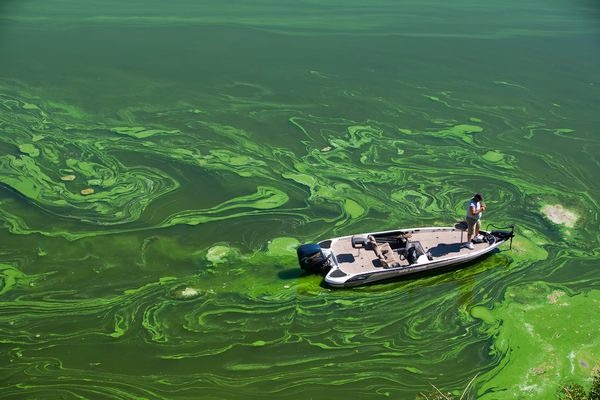Think This Improvement Area is Right for Your Lake?
☐ I have noticed a lot of algae growing in the lake
☐ I have noticed a lot of expired wildlife (mammals, birds, fish) around the edges of or near the lake
☐ The surrounding shoreland of the lake is occupied by many residents
☐ People enjoy using the lake for recreational activities such as boating, swimming, and fishing
If you’ve answered YES to the above questions, the Nutrients, Sprays, and Chemical Applicants Improvement Area may be beneficial for your lake!
An Interconnected System

Your lake is part of a larger interconnected water system called a watershed. The watershed is an area of land that contains a common set of small streams, rivers, wetlands, and lakes, that all drain into a larger receiving water body, which is typically a larger lake. This interconnectedness between the land and water means that what we do on the land can have drastic effects on the health and integrity of the water.
While many people like to use fertilizers for enhancing their lawns and chemicals to remove pests from their property, excessive use of fertilizers, herbicides, or pesticides can create large problems for lake ecosystems. It’s our job to ensure what we’re doing on our own properties is not having a negative influence on the ecosystem around us!
Nutrients
Excess nutrients can enter a water body typically in the form of fertilizers. The excess nutrients can cause a phenomenon called eutrophication, causing an increase in algal growth. This algae can grow in dense mats along the lake surface, closing off the lake to sunlight.
Lack of sunlight causes plants that grow along the bottom of the lake to die and decompose, using up all the dissolved oxygen present in the water. This “chokes” out the lake and its inhabitants in the process, creating what are called dead zones.
Sometimes these algal blooms can be dangerous to humans and wildlife. Toxic cyanobacteria or blue-green algae can have severe effects on the health and wellbeing of all living things, so preventing and monitoring these blooms is a top priority!

Think You've Seen a Blue-Green Algae Bloom?
Don’t panic, but avoid the water for now! Do not drink, bathe, swim, or play in the water and keep pets away. Always assume toxins are present, better to be safe than sorry!
To report a suspected blue-green algal bloom, you can submit a report online or contact the Spills Action Centre at 1-966-MOE-TIPS (663-8477).
Chemical Sprays & Applicants
Chemical sprays like herbicides, insecticides, and pesticides can have incredibly harmful effects on biodiversity within a lake ecosystem.
Mosquitoes are attracted to LED lights and open spaces where natural predators such as dragonflies and songbirds are lacking.
All mosquito sprays, including natural types, contain nerve tonics that can be harmful to pregnant women, but which are also broad spectrum and remove key pollinators as well as food for songbirds, fish, and amphibians. Declines in songbirds have reached 75% amongst some species in the last 20 years, many of which relate directly to mosquito sprays and insecticides that are exacerbated by LED lights/night lights and native habitat destruction.
Mosquito sprays can also leach into lake ecosystems and harm zooplankton and other essential aquatic animals. Other chemical sprays and applicants like herbicides and other pesticides can also remove the foundation of food webs or have other secondary impacts to wildlife.
Plants Are Your Friends!

By planting a vegetated buffer between your lawn and the lake, these plants will act as a natural filter for excess nutrients and chemicals moving from your property into the lake. Vegetated buffers can also help prevent flooding and erosion of your property by acting like a barrier against wakes and wind.
Ideally, these buffers will be at least 30 m and contain diverse, native species, but if you’re short on space 10-15 m will work as well.
Something is better than nothing!
What Can I Do To Reduce My Own Impacts?
Avoid using fertilizers on your lawn!
Turf grass is not great at filtering, causing this influx of nutrients to enter the lake from fertilizers.
Avoid the use of excess chemicals (herbicides, insecticides, pesticides) on your property!
Plant vegetated buffer strips between your lawn and the lake with diverse native plants!
Not only will this keep nutrients from entering the lake, but it will also provide areas of habitat and foraging for the wildlife you share your property with.
Ensure your property is being properly maintained with inspections of equipment (septic tanks, irrigation systems, buildings, etc) occurring on a regular basis.
Want To Learn More?
The Blue Lakes Program has put together resources on how property owners can reduce runoff from nutrients and chemical sprays on their property. You can launch this guide below!
